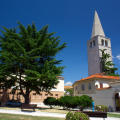EUPHRASIAN BASILICA
Imposing basilica with Unesco World Heritage interior, high above the town of Poreč.
In the 6th century, Euphrasius, the first bishop of Poreč, commissioned the construction of this great basilica to accommodate the growing community of early Christians. But the project proved too ambitious. The visionary patron ordered the work to be halted, and a sober, hieratic building, as we know it today, was erected at lower cost. The large baptistery dates from the5th century.
Since 1997, the interior of the basilica has been a Unesco World Heritage Site, especially for the remarkable mosaic murals in the main apse. Dating from the 6th century AD, the scenes are impressive both for the impressive size of the figures and the perfect state of preservation of the chromatic tesserae. The triumphal arch depicts the blessing of Christ, surrounded by the twelve apostles, all dressed in white, each with a personal inscription. Christ standing on the globe holds a book open to the words Ego sum lux vera: "I am the true light". A row of medallions featuring saints on a dark background returns to the central medallion depicting the Agnus Dei against a star-studded sky. On the apse cap, Christ is presented by the Virgin on the throne. Their heads touch a cloudy sky, from which emerges a hand brandishing the crown. They are accompanied by angels and martyrs, St. Maur, Bishop Euphrasius, Archdeacon Claudius and his son, and the builder of the basilica, holding the model of his edifice. In the lower register, on the two panels on either side of the apse, St. John the Baptist and St. Zacharias, as well as scenes from the Annunciation and the Visitation, show the flowering of the cult of the Virgin under Byzantine influence.
A 12th-century baldachin crowns the altar. Its decoration of mother-of-pearl and oyster shells is reminiscent of Greek temples. The treasury contains relics, numerous manuscripts and 15th-century paintings. Frescoes that once adorned the side walls were restored by the Republic of Venice, but later destroyed. Other floor mosaics are also very well preserved. They depict the fish, symbol of the early Christians. The later mosaics on the entrance door date from the 19th century. You can climb the steps to the bell tower (panoramic view). An annual classical music festival is held in the nave in late summer.
Did you know? This review was written by our professional authors.
Book the Best Activities with Get Your Guide
Members' reviews on EUPHRASIAN BASILICA
The ratings and reviews below reflect the subjective opinions of members and not the opinion of The Little Witty.

Find unique Stay Offers with our Partners




